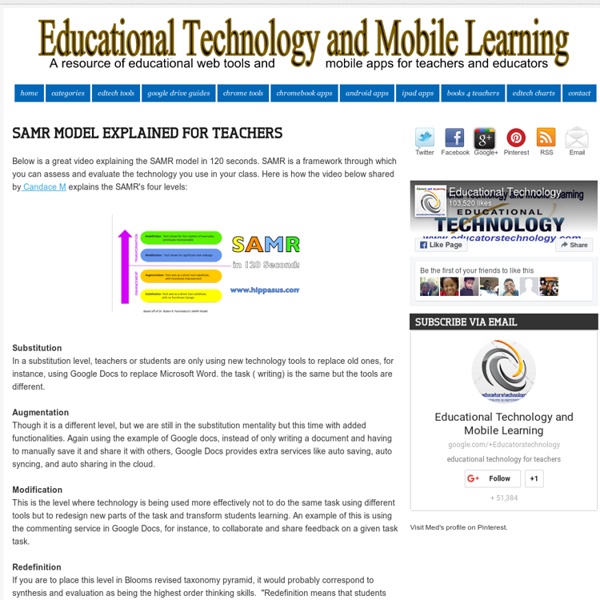Educational Technology and Mobile Learning: Eight Free tools for Teachers to Make Awesome Infographics
1- Easel.ly This is a great tool that allows users to create visually rich infographics from pre-designed themes. It is very easy to use and only drag and drop. It actually supports Chrome, Firefox, and Safari. 2- Stat Planet This one here allows users to create amazing visualisations and share them with others. It can be used either within your browser or download the software for free.
Clearing the Confusion between Technology Rich and Innovative Poor: Six Questions
** We are seeking global opinions, please consider commenting with your thoughts and ideas of the definition of innovation** In a recent webinar, more than 90% of school leaders responded that they were leading an innovative school as a result of the implementation of technology. At the end of the webinar, when polled again, only one leader claimed to be leading an innovative school. The complete reversal was due to a presentation of the Six Questions that you will read about in this article. This list of questions was developed to help educators be clear about the unique added value of a digital learning environment. Test your own level of innovation.
Educational Technology and Mobile Learning: A Simple Tool to Create Stunning Video Animations for Your Class
September 19, 2015 Biteable is a web-based tool that allows you to create beautiful explainer videos to share with your students. Explainer videos are short animated clips that make use of a wide variety of visuals and multimedia materials to communicate a message in a concise and comprehensible way. You probably have already seen some examples of Explainer videos on ads played on YouTube, several companies use this kind of videos to advertise their products. However, as a teacher, you can create explainer videos to explain key concepts, create instructional guides and tutorials to share with students and many more. You don’t need advanced video editing skills to use Biteable. The process is simple and easy.
Group Work Strategies to Ensure Students Pull Their Weight
The idea for sharing this post came from a session I recently conducted at the annual teaching conference organized by my university. A pedagogical conundrum was raised by a colleague whose enthusiasm and question stayed with me and inspired me to write this post. The question posed by this colleague is relevant to all instructors who have ever used group work to assess their students: How should one deal with the issues that arise when members of a group are not picking up their share of the responsibilities during a group work project? The benefits of group work are well recognized (e.g., as are the reasons students don’t like working in groups (Taylor, 2011). We have all had groups that operated magically, when group members brought out each other’s strengths and helped each member shine; but we have also had groups that failed miserably when members did not get along or did not pull equal weight in completing a group project. 1.
Mr. C's SharesEase
This great video clearly outlines Genius Hour movement happening in classrooms across the world! After reflecting for a few months on how to initiate #GeniusHour in my classroom I finally jumped in with both feet, my Genius Journal (click to download) and the question, “What do YOU want to learn Today”? The response, learning, level of engagement and finished products were incredible! I found my Genius Journal to be incredibly helpful in guiding my students, allowing them to follow a process (QUESTION-PLAN-RESEARCH-CREATE-SHARE-REFLECT) and record their learning.
A Portrait of Smartphone Ownership
As smartphones have grown increasingly common in recent years, these devices have taken on a central role in the information lives of a substantial number of Americans. And yet, those Americans who rely most heavily on their smartphones as a gateway to online services and information are often the ones whose connections to their devices are most tenuous. This chapter of the report examines the general state of smartphone ownership in America today, with a focus on how these devices fit into the digital access options available to their owners.
6 Important Components Of Online Pedagogy
Originally posted on What makes you a good instructor in the classroom – does not necessarily translate to good pedagogy in an online learning environment. Online Learning Environments are becoming increasingly available for learners in all areas of education from primary grades right through to higher education. They require key considerations to be cultivated to promote success. The Components Of A Successful Online Learning Environment Whether you are building an Online Learning framework for primary students, college students, or for professional development among your colleagues, the basic premise remain the same – the Online Learning Environment should enhance the learning potential of your candidates. The SAMR model, created by Reuben Puentedura, is one example of how we can think about eLearning design.
3 Ways Coding and Gaming Can Enhance Learning
Coding isn't just for computer science any more. Educators are finding that teaching students to write code and design games enhances learning and creates engagement. These examples illustrate how coding and games are being used across the curriculum and at all levels, as well as why great teaching is at the very heart of this innovation. Connecting With Each Learner: Inform7 (Interactive Fiction for High School) Imagine a weather-beaten oak door.



